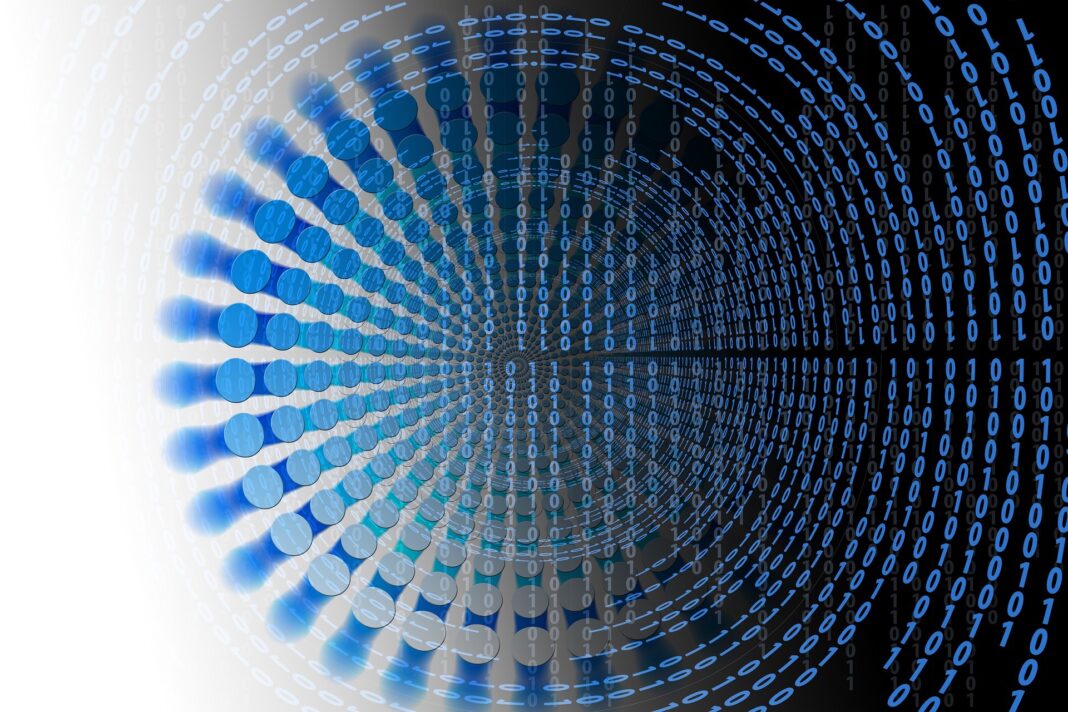Our lives are getting increasingly dependent on digital data. Whether it is big data that various industries use to tailor their products and services, or the images and videos we share via Instagram or WhatsApp, it’s hard to imagine our life without them. But what exactly is this ‘data’? How is it stored and transferred across digital devices?
The different ways in which we exchange information—pictures, videos, programs, and documents—look equal in the eyes of our computers: each file is a sequence made from two types of building blocks: ‘0’s and ‘1’s. When we save, upload or download a file, that specific sequence of ‘0’ and ‘1’ bits is stored onto our personal computer, or onto one of the many computers owned by social media companies housed in data centers around the world. A small 1-kilobyte text file has 8192 bits*, while an image of size 1 MB has 8388608 bits.
Within the computers, these bits are physically ‘written’ on Hard Disk Drives (HDDs) so they can be retrieved later, even after switching the computers off and on multiple times. These HDDs then require a medium onto which the bits can be stored, which can stabilize in two kinds of states, corresponding to ‘0’ or ‘1’. Most of our current storage technology uses magnetism to do this.
The mysterious force we use to stick our travel souvenirs to the fridge is the same one used to store our digital data! Fridge magnets have two poles, N and S —like poles repel and unlike poles attract. These magnets can be broken up into smaller magnets until we eventually get single-atom magnets —called ‘spins’. The direction these spins point in determines the ‘N’ and ‘S’ for that atom. The magnetism of the fridge magnet results from each spin ‘talking’ to its neighboring spins via the ‘exchange interaction’ which makes the spins coordinate and order in certain arrangements. Some arrangements arising from different types of exchange interactions are shown in Figure 1.
If a fridge magnet is heated up, it loses its magnetic strength, or ‘magnetization’, until it eventually stops showing any magnetic behavior. For an overall magnetic response, the ‘crosstalk’ between spins (enabled by the exchange interaction) and the resulting ordering of the spins is crucial. Heat increases the thermal ‘noise’ over which the crosstalk becomes harder to resolve until eventually, the spins cannot hear each other at all.
The HDDs store our data on a magnetic film full of atomic spins. The states ‘0’ and ‘1’ are defined by two directions of these atomic spins i.e., whether ‘N’ points upwards downwards. The storage capacity of the HDD depends on how many bits can be crammed into the limited area of the magnetic film. Bits are ‘written’ using a minuscule electromagnet (Figure 2), through which current is passed, creating a strong magnetic field focused over a small region of the magnetic film. The magnetic film forces the spins to precess like a spinning top and eventually settle into a ‘0’ or ‘1’ state within a nanosecond (a billionth of a second!).
Figure 2 shows the magnetic surface of an HDD viewed with a special kind of high-resolution microscope, with the two magnetic states seen as black and white areas. For perspective, consider a strand of hair that is 100 μm – it can fit 200 such images! That’s how an HDD with a capacity of terabytes (1 terabyte = 8796093022208 bits) fits into the palm of our hand.
However, the advanced HDD technology cannot keep up with the current demand. The data we are collectively producing, and the data centers needed to store it, are growing exponentially, as is the associated energy cost. The electromagnets writing the magnetic bits consume energy – the faster the writing, the more the energy consumption. The energy toll builds up with cooling and maintenance requirements of data centers, amounting to about 200 terawatt-hours annually – more than the national consumption of Iran! The crisis can be combatted by finding new ways to write data faster, with greater energy-efficiency, and cram more of it in a given space.
An astoundingly efficient technology
To this end, a fascinating observation was reported by scientists in 2007 in a ferrimagnetic material, Gd-Fe, made of magnetic elements gadolinium (Gd) and iron (Fe) (and a small amount of cobalt). Magnetic bits could be written on this material without any magnetic field, using solely light pulses from a laser! Such pulsed lasers emit very short bursts of light, lasting for as short as one picosecond (one trillionth of a second!). These lasers are so precise that they are used in surgery for their highly localized heating. The pulsed laser focused onto an area of the Gd-Fe film unexpectedly reversed the magnetization of the area a thousand times faster than a magnetic field! The process occurred in a time window too short for the spins to ‘talk’ to each other. So how does this work?
After much experimental effort, the answer was revealed seven years later in 2013. In a challenging and sophisticated experiment, scientists ‘tagged’ the Gd and Fe spins to track their evolution in a few picoseconds following laser excitation. They used a technique called ‘pump-probe’ spectroscopy, where a high-power laser pulse (‘pump’) excites the system, and a low-power pulse ‘probes’ the magnetic state of the sample. The probe pulses act as a camera with a very fast shutter. Instead of recording an actual picture of the spins, the magnetic state is indirectly recorded by measuring its effect on the polarization of the laser. Several pump-probe pairs are measured in one experiment – each time, the probe arrives a few picoseconds later relative to the pump ( e.g., 1 picosecond before the pump, at the same time as the pump, 0.5 picoseconds after the pump, and so on…) In this way, the process can be tracked at a timescale shorter than picoseconds. To ‘tag’ the spins, the ‘probe’ laser wavelength was chosen from the x-ray regime (0.01 – 10 nanometers), instead of visible wavelengths (400 – 700 nanometres) since every element has a characteristic x-ray wavelength at which it shows a prominent response. Thus, Gd and Fe spins could be ‘tagged’ by probing at their characteristic x-ray wavelengths, revealing how the magnetic ordering in the GdFe helped in the laser-induced reversal (Figure 3).
Figure 3: Cartoon showing time-evolution of Fe and Gd spins leading to the magnetic switching
Before the hit, the ferrimagnetic ‘interaction’ between the Gd and Fe spins makes them align antiparallel to each other, but the magnetization is not completely canceled out due to different strengths of the Fe and Gd spins. The laser pulse acts as a short and intense burst of heat, rapidly reducing the magnetization of these. The Gd and Fe respond at different speeds to the same burst of heat – in fact, Fe spins lose their magnetization thrice as fast as Gd.
This difference in response is important to create a favorable situation for the magnetization ‘switching’. By the time Fe spins have lost all of their magnetizations, the Gd spins are still weakly magnetic. The Fe spins start to point parallel to the weakly magnetic and slowly demagnetizing Gd spins. Simultaneously, the heat added by the laser is flowing through the film into the neighboring areas, cooling down the environment at an even slower rate.
As the temperature gradually reduces, the spins are once again able to listen to the ‘interaction’ that commands all the Fe spins to point opposite to the Gd spins. With the cooling, the ‘crosstalk’ becomes stronger again, commanding the Gd spins to reverse their direction, leading to an overall switch of the magnetization. This complex interplay between the atomic spins and the heat flow in the film is complete within a few picoseconds! Not only is the reversal a thousand times faster compared to a reversal in HDDs, but it also consumes at least a thousand times lesser energy. Considerable research is going on to explore possibilities to lower the energy consumption and material costs of this process even further.
Is this all-optically driven switching the answer to our data-woes?
Well, there are still some obstacles in the way. A magnetic field gives us complete control to write our bits as ‘0’ or ‘1’, as dictated by the field. The all-optical mechanism seen in Gd-Fe only ‘toggles’ the magnetic material from ‘0’ to ‘1’ and vice versa. It would be good to have control over the final direction of the bits. Another issue is the smallest bit size attainable with this technology. Conventional optics cannot focus the laser tighter than a few micrometers due to the diffraction limit. This compares poorly with the nanometer-sized bits in HDDs. There are many open questions and challenges that both science and engineering need to tackle before we find all-optical switchable memory devices in our computers.
References
- Nature Editorial. (2018, September 12). How to stop data centres from gobbling up the world’s electricity. Nature. Retrieved January 26, 2022, from https://www.nature.com/articles/d41586-018-06610-y
Footnote
*This strange conversion arises due to the binary nature of the memory: a single bit can hold 2 values – 0 and 1. 2 bits combined can hold 22 or 4 different possibilities of information: (0,0), (0,1), (1,0) and (1,1). The more the number of bits, the more possibilities we can uniquely encode using them. A total of 256 characters (upper and lower case letters of the alphabet, numbers, and special symbols) are the building blocks of the information we commonly write into our files. To uniquely represent each of these 256 (or 28) characters, a group of 8 bits (called a ‘byte’) is sufficient. A file having multiple characters needs more bits, expressed as powers of 2: 21, 22 23… Larger file sizes are expressed in terms of ‘kilobytes’, which comprises 210 bytes, or 1024 bytes – this number is close enough to 1000 bytes, hence the ‘kilo’.





